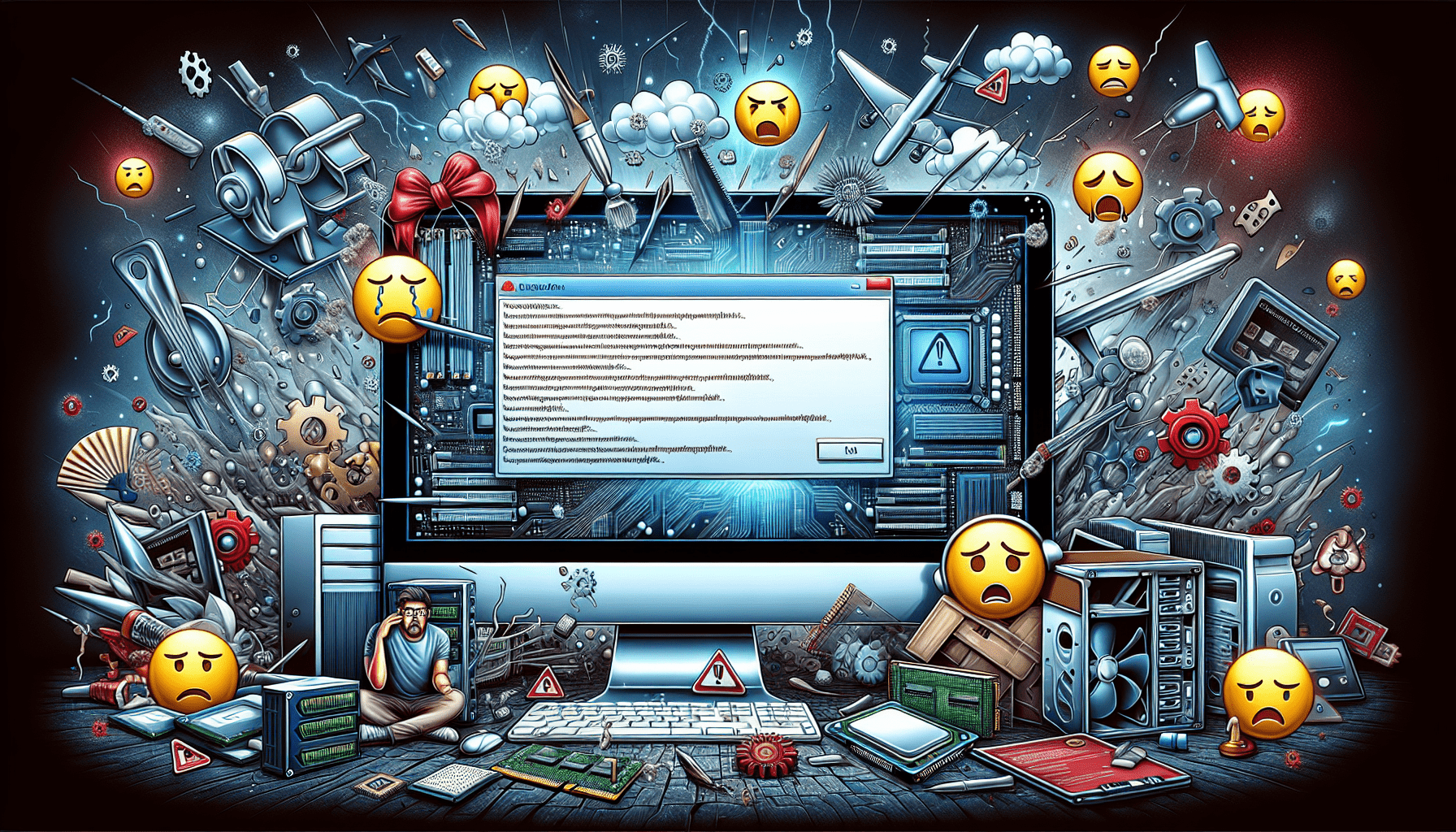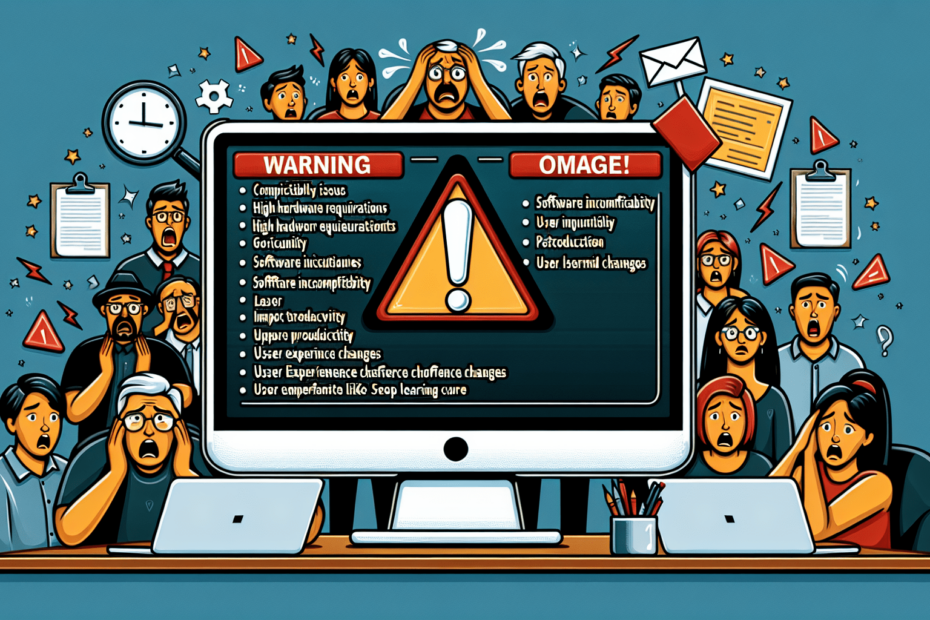







Are you considering upgrading to Windows 11, but you’re hesitant because you’re not sure what the potential downsides might be? Look no further! In this article, we’ll explore the possible disadvantages that come with upgrading to Windows 11. By the end, you’ll have a clearer understanding of whether or not this upgrade is the right choice for you. So, let’s dive right in and discover what Windows 11 has in store for you!
Incompatibility with Older Hardware
Limited hardware compatibility
Upgrading to Windows 11 may result in limited hardware compatibility. While newer hardware is likely to be supported, older devices may not meet the minimum requirements for the new operating system. This means that if your computer or device is several years old, there’s a chance that it won’t be able to run Windows 11 smoothly or at all. As a result, you may need to purchase a new device or upgrade your existing hardware to ensure compatibility.
Additional cost of upgrading hardware
The limited hardware compatibility mentioned earlier may require you to spend additional money in order to upgrade your existing hardware. To run Windows 11 effectively, you may need to invest in a new computer or update components such as the processor, RAM, or storage. This can be a considerable expense for some individuals or businesses, especially if they weren’t planning on upgrading their hardware in the near future.
Loss of Compatibility with Older Software
Inability to run older software
When upgrading to a new operating system like Windows 11, it’s not uncommon for older software applications to become incompatible. This means that some of the programs you may be accustomed to using on your current Windows version might not work on Windows 11. This can be a significant drawback, especially if you rely heavily on certain applications or have specialized software that may not have an updated version available.
Need to purchase updated software
If your current software becomes incompatible with Windows 11, you may need to purchase updated versions, if they are available. In some cases, software developers may offer discounted or free upgrades, while in others, you may have to pay the full price for the updated software. This additional cost can add up, especially if you rely on several different software applications for your work or personal use.

Changes in User Interface
Adaptation to new interface
Windows 11 introduces a new user interface compared to previous Windows versions. While some people might appreciate the fresh design and modern aesthetic, others may find it challenging to adapt to the changes. Switching to a new interface can take some time and effort to become familiar with the new layout, menus, and features. It may require you to relearn how to navigate and perform tasks that you were previously accustomed to.
Learning curve for new features
Along with the new interface, Windows 11 also introduces new features and functionalities. While these additions can enhance the user experience, they also come with a learning curve. You may need to invest time in understanding and mastering these new features to fully benefit from them. This learning process can be frustrating or time-consuming for individuals who are not comfortable with technology or prefer to stick with what they’re familiar with.
Potential Software Bugs and System Instability
Initial release may have bugs
Every new operating system release, including Windows 11, is likely to have some initial bugs and glitches. Despite rigorous testing prior to launch, it is nearly impossible to identify and resolve all issues before the release date. This means that after upgrading, you may encounter unexpected software bugs that can disrupt your workflow or cause system instability. It’s important to remember that these issues are typically addressed through updates and patches released by Microsoft.
Compatibility issues with third-party software
Along with potential bugs in the operating system itself, there may also be compatibility issues between Windows 11 and third-party software applications. Since developers need time to update their software to be fully compatible with the new operating system, there may be a period where certain applications do not work as expected or encounter compatibility issues. This can be particularly problematic if you rely on specific third-party software for your work or daily tasks.
System crashes or freezes
Another potential drawback of upgrading to Windows 11 is the possibility of experiencing system crashes or freezes. As with any new software, there is a chance that your system may become unstable after the upgrade. This can be frustrating and disruptive, especially if you’re in the middle of an important task or project. However, it’s worth noting that Microsoft typically releases updates and fixes to address these issues as they are discovered and reported by users.

Higher System Requirements
Increased demand for system resources
Windows 11 has higher system requirements compared to older Windows versions. This means that the new operating system may require more processing power, memory, and storage to run smoothly. If your computer or device does not meet these increased requirements, you may experience performance issues, such as slower response times or lag. Upgrading your hardware to meet these requirements can be costly, as mentioned earlier.
Need for more powerful hardware
In line with the higher system requirements, upgrading to Windows 11 may necessitate investing in more powerful hardware. This could mean purchasing a new computer or upgrading components such as the processor, RAM, or storage. The cost of acquiring these more advanced and capable hardware components can be a significant investment, especially if you were not planning on upgrading your device in the near future.
Loss of Control over Updates
Automatic updates may disrupt workflow
With Windows 11, Microsoft is shifting towards a more frequent and automatic update system. While this can ensure that your operating system is always up to date with the latest features and security patches, it also means that updates can occur at inconvenient times. Automatic updates can potentially disrupt your workflow, especially if they initiate during critical tasks or presentations. It is crucial to plan and manage your work accordingly to minimize any potential disruptions.
Loss of choice in selecting updates
Upgrading to Windows 11 means accepting Microsoft’s update policy, which includes a certain level of loss of control over selecting updates. While your system will receive important security patches and bug fixes, you may not have the freedom to choose which updates to install or delay their installation. This loss of control can be a concern for individuals who prefer to have more agency in managing their operating system updates based on their specific needs or preferences.
Privacy Concerns
Data collection and telemetry
Privacy is always a concern when it comes to operating systems, and Windows 11 is no exception. There have been discussions and debates regarding the extent of data collection and telemetry features in the new operating system. Some users may worry about the amount of personal information that Microsoft collects and how it is utilized. While Microsoft has implemented privacy settings and options to address these concerns, it is important to review and adjust these settings according to your comfort level and privacy preferences.
Privacy settings and options
Windows 11 offers privacy settings and options that allow users to customize their privacy preferences to a certain extent. It is essential to carefully review and adjust these settings according to your privacy needs and concerns. By taking the time to understand and manage these settings, you can have more control over the information you share and enhance your overall privacy while using the operating system.
Hardware Driver Issues
Incompatibility with older hardware drivers
Upgrading to Windows 11 may result in the incompatibility of older hardware drivers. If your device or peripherals rely on specific drivers that are not supported or compatible with Windows 11, you may experience issues. This can range from reduced functionality to complete non-functionality of certain devices. Finding updated drivers for older hardware can be challenging, as some manufacturers may not release updated drivers for discontinued or older models.
Difficulty in finding updated drivers
Locating and acquiring updated drivers for older hardware can be a time-consuming and frustrating process. If the manufacturer does not provide updated drivers for Windows 11, you may have to search for alternative sources or rely on generic drivers, which may not offer the same level of performance or compatibility. The lack of compatible drivers can limit the functionality of your devices or prevent them from working altogether.
Potential Security Vulnerabilities
New operating system may have undiscovered vulnerabilities
As with any new operating system, Windows 11 may have undiscovered vulnerabilities that could potentially be exploited by malicious actors. While Microsoft dedicates significant resources to ensuring the security of their operating systems, the discovery of vulnerabilities is an ongoing process. Users who upgrade to Windows 11 may be exposed to these new and yet-to-be-discovered security risks, at least until they are identified, reported, and addressed through security patches and updates.
Delay in receiving security patches for older Windows versions
As the focus shifts to supporting the latest operating system, older Windows versions may receive security patches and updates with a delay or reduced frequency. This means that if you choose to stick with an older version of Windows instead of upgrading to Windows 11, you may be at higher risk of encountering security vulnerabilities. It is important to consider the potential risks and weigh them against the advantages or benefits of upgrading when deciding whether to switch to Windows 11 or stay with your current version.
Transition Period and Migration Challenges
Time and effort required to back up and migrate data
Migrating from one operating system to another, such as upgrading to Windows 11, often requires time and effort to back up and migrate your data. This process involves transferring files, settings, and applications to the new operating system. Depending on the amount of data you have, the complexity of your setup, and your familiarity with the migration process, this transition period can be time-consuming and may require troubleshooting and problem-solving along the way.
Adapting to new workflow and features
Switching to Windows 11 means adapting to a new workflow and features. This can take time, particularly if you were accustomed to the workflow and functionalities of the previous Windows version. You may need to reconfigure your settings, customize the new operating system to align with your preferences, and learn how to use any new features that are introduced. This adaptation process requires patience, a willingness to learn, and an openness to change in order to fully utilize the capabilities of Windows 11.







